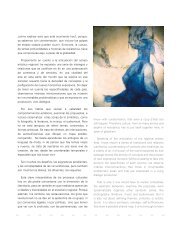yacían ensangrentados en las instalaciones carcelarias. Sesenta y ...
yacían ensangrentados en las instalaciones carcelarias. Sesenta y ...
yacían ensangrentados en las instalaciones carcelarias. Sesenta y ...
You also want an ePaper? Increase the reach of your titles
YUMPU automatically turns print PDFs into web optimized ePapers that Google loves.
Mi realidad <strong>en</strong> blanco y<br />
negro…mis derechos <strong>en</strong><br />
blanco y negro<br />
Estoy <strong>en</strong>fermo, claro, muy <strong>en</strong>fermo,<br />
todos<br />
están <strong>en</strong>fermos <strong>en</strong> la ciudad que habito.<br />
Anda drogado y sucio el odio por as calles<br />
y sufre oscuram<strong>en</strong>te<br />
de frío la cabeza.<br />
Limite<br />
Un mundo para todos dividido<br />
Roberto Sosa<br />
Estos artistas, que ati<strong>en</strong>d<strong>en</strong> f<strong>en</strong>óm<strong>en</strong>os singulares del<br />
llamado ord<strong>en</strong> posmoderno y poscolonial, desestimados<br />
por <strong>las</strong> estructuras oficiales, respond<strong>en</strong> a una demanda<br />
insatisfecha de <strong>en</strong>t<strong>en</strong>der y explicar los procesos<br />
responsables de <strong>las</strong> luchas, <strong>en</strong>cu<strong>en</strong>tros y obstrucciones<br />
de la sociedad hondureña actual. Veamos el interesante<br />
caso de Johanna Montero, una jov<strong>en</strong> artista que desde<br />
una economía de recursos extraordinaria, un l<strong>en</strong>guaje<br />
espontáneo y directo, propone un acercami<strong>en</strong>to “plástico”<br />
a leyes que, aunque conciern<strong>en</strong> a absolutam<strong>en</strong>te todos<br />
los ciudadanos son, por lo g<strong>en</strong>eral, desat<strong>en</strong>didas.<br />
Johanna Montero, una de <strong>las</strong> pocas artistas mujeres<br />
<strong>en</strong> actual ejercicio <strong>en</strong> Honduras, maneja como tema <strong>en</strong> su<br />
obra Gritos, <strong>las</strong> distancias que separan a una ley escrita<br />
y su posterior arrinconami<strong>en</strong>to <strong>en</strong> una esquina oscura de<br />
la sociedad civil. Sus propuestas, como <strong>las</strong> de César y<br />
otros artistas que veremos posteriorm<strong>en</strong>te, desbordan<br />
<strong>las</strong> fronteras del país para convertirse <strong>en</strong> un reclamo<br />
universal contra formas de viol<strong>en</strong>cia estructural, muchas<br />
veces inapreh<strong>en</strong>sibles, que laceran el bu<strong>en</strong> desarrollo de<br />
naciones completas. Utilizando como base la Declaración<br />
Universal de los Derechos Humanos aprobada por la<br />
ONU <strong>en</strong> 1948, Johanna hace públicos <strong>en</strong> <strong>las</strong> calles de su<br />
país, una selección de artículos que llaman la at<strong>en</strong>ción<br />
sobre derechos elem<strong>en</strong>tales de hombres y mujeres,<br />
desoídos por estructuras oficiales y lo que resulta más<br />
<strong>en</strong>gorroso, de casi total desconocimi<strong>en</strong>to <strong>en</strong> los propios<br />
ciudadanos.<br />
6.2 My reality in black and white…<br />
my rights in black and white<br />
I’m sick, clearly very sick,<br />
All<br />
Are sick in the city I inhabit.<br />
Hate walks the streets drugged and dirty,<br />
and my head<br />
Suffers, darkly, of cold.<br />
Limit<br />
A World for All Divided<br />
Roberto Sosa<br />
These artists, singular ph<strong>en</strong>om<strong>en</strong>ons of the so-called<br />
postmodern and colonial order, undervalued by the<br />
official structures, respond to an unqu<strong>en</strong>ched demand<br />
of understanding and explaining the processes behind<br />
the struggles, <strong>en</strong>counters, and obstructions of pres<strong>en</strong>t<br />
Honduran society. Lets study the interesting case of<br />
Johanna<br />
Montero, a young artist that, with an extraordinary<br />
economy of resources, and in a language both<br />
spontaneous and direct, proposes a “visual arts”<br />
approach to laws which, although being a concern of<br />
absolutely all citiz<strong>en</strong>s, are most usually unheeded.<br />
Johanna Montero, one of the few wom<strong>en</strong> artists in<br />
pres<strong>en</strong>t day Honduras, uses as subject matter in her<br />
work Gritos (“Cries”) the distance betwe<strong>en</strong> a writt<strong>en</strong><br />
lay and its dumping in a dark corner of civil society. Her<br />
works, like those of Manzanares and others, transc<strong>en</strong>d<br />
the country borders to become a universal claim<br />
against forms of structural viol<strong>en</strong>ce, oft<strong>en</strong> difficult to<br />
grasp, which lacerate the proper developm<strong>en</strong>t of whole<br />
nations. Using as a basis the Universal Declaration of<br />
Human Rights approved by the UN in 1948, Montero<br />
makes public in the streets of her country a selection<br />
of articles drawing att<strong>en</strong>tion to basic rights of m<strong>en</strong> and<br />
wom<strong>en</strong>, ignored by the official authorities, and, which is<br />
ev<strong>en</strong> more embarrassing, almost completely unknown<br />
by the population.<br />
30 32 34 36 38 40 42 44 46 48 50 52 54 56



